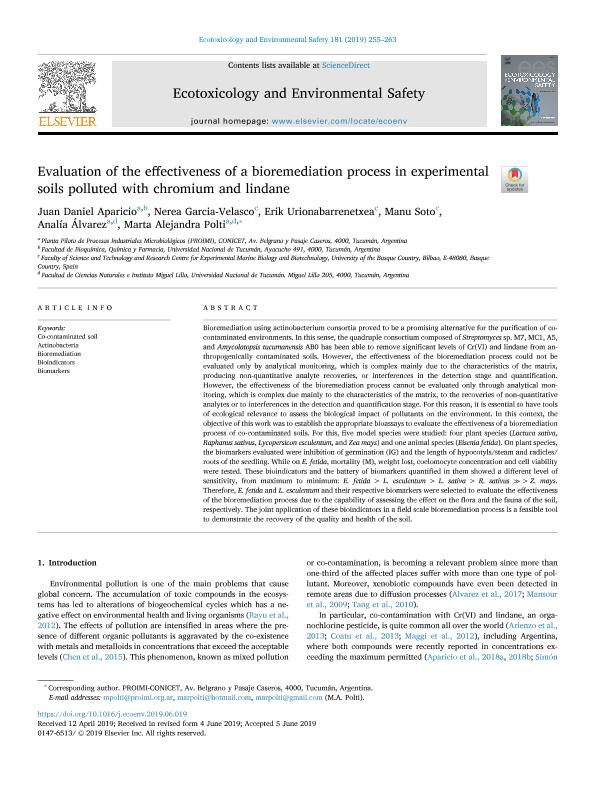Mostrar el registro sencillo del ítem
dc.contributor.author
Aparicio, Juan Daniel

dc.contributor.author
Garcia Velasco, Nerea
dc.contributor.author
Urionabarrenetxea, Erik
dc.contributor.author
Soto, Manu
dc.contributor.author
Álvarez, Analía
dc.contributor.author
Polti, Marta Alejandra

dc.date.available
2019-12-11T19:01:47Z
dc.date.issued
2019-10
dc.identifier.citation
Aparicio, Juan Daniel; Garcia Velasco, Nerea; Urionabarrenetxea, Erik; Soto, Manu; Álvarez, Analía; et al.; Evaluation of the effectiveness of a bioremediation process in experimental soils polluted with chromium and lindane; Academic Press Inc Elsevier Science; Ecotoxicology and Environmental Safety; 181; 10-2019; 255-263
dc.identifier.issn
0147-6513
dc.identifier.uri
http://hdl.handle.net/11336/92017
dc.description.abstract
Bioremediation using actinobacterium consortia proved to be a promising alternative for the purification of co-contaminated environments. In this sense, the quadruple consortium composed of Streptomyces sp. M7, MC1, A5, and Amycolatopsis tucumanensis AB0 has been able to remove significant levels of Cr(VI) and lindane from anthropogenically contaminated soils. However, the effectiveness of the bioremediation process could not be evaluated only by analytical monitoring, which is complex mainly due to the characteristics of the matrix, producing non-quantitative analyte recoveries, or interferences in the detection stage and quantification. However, the effectiveness of the bioremediation process cannot be evaluated only through analytical monitoring, which is complex due mainly to the characteristics of the matrix, to the recoveries of non-quantitative analytes or to interferences in the detection and quantification stage. For this reason, it is essential to have tools of ecological relevance to assess the biological impact of pollutants on the environment. In this context, the objective of this work was to establish the appropriate bioassays to evaluate the effectiveness of a bioremediation process of co-contaminated soils. For this, five model species were studied: four plant species (Lactuca sativa, Raphanus sativus, Lycopersicon esculentum, and Zea mays) and one animal species (Eisenia fetida). On plant species, the biomarkers evaluated were inhibition of germination (IG) and the length of hypocotyls/steam and radicles/roots of the seedling. While on E. fetida, mortality (M), weight lost, coelomocyte concentration and cell viability were tested. These bioindicators and the battery of biomarkers quantified in them showed a different level of sensitivity, from maximum to minimum: E. fetida > L. esculentum > L. sativa > R. sativus ≫> Z. mays. Therefore, E. fetida and L. esculentum and their respective biomarkers were selected to evaluate the effectiveness of the bioremediation process due to the capability of assessing the effect on the flora and the fauna of the soil, respectively. The joint application of these bioindicators in a field scale bioremediation process is a feasible tool to demonstrate the recovery of the quality and health of the soil.
dc.format
application/pdf
dc.language.iso
eng
dc.publisher
Academic Press Inc Elsevier Science

dc.rights
info:eu-repo/semantics/openAccess
dc.rights.uri
https://creativecommons.org/licenses/by-nc-nd/2.5/ar/
dc.subject
ACTINOBACTERIA
dc.subject
BIOINDICATORS
dc.subject
BIOMARKERS
dc.subject
BIOREMEDIATION
dc.subject
CO-CONTAMINATED SOIL
dc.subject.classification
Bioremediación, Diagnóstico Biotecnológico en Gestión Medioambiental

dc.subject.classification
Biotecnología del Medio Ambiente

dc.subject.classification
INGENIERÍAS Y TECNOLOGÍAS

dc.title
Evaluation of the effectiveness of a bioremediation process in experimental soils polluted with chromium and lindane
dc.type
info:eu-repo/semantics/article
dc.type
info:ar-repo/semantics/artículo
dc.type
info:eu-repo/semantics/publishedVersion
dc.date.updated
2019-12-11T18:52:20Z
dc.journal.volume
181
dc.journal.pagination
255-263
dc.journal.pais
Estados Unidos

dc.journal.ciudad
New York
dc.description.fil
Fil: Aparicio, Juan Daniel. Universidad Nacional de Tucumán; Argentina. Consejo Nacional de Investigaciones Científicas y Técnicas. Centro Científico Tecnológico Conicet - Tucumán. Planta Piloto de Procesos Industriales Microbiológicos; Argentina
dc.description.fil
Fil: Garcia Velasco, Nerea. Universidad del País Vasco; España
dc.description.fil
Fil: Urionabarrenetxea, Erik. Universidad del País Vasco; España
dc.description.fil
Fil: Soto, Manu. Universidad del País Vasco; España
dc.description.fil
Fil: Álvarez, Analía. Universidad Nacional de Tucumán. Facultad de Ciencias Naturales e Instituto Miguel Lillo. Instituto Miguel Lillo; Argentina. Consejo Nacional de Investigaciones Científicas y Técnicas. Centro Científico Tecnológico Conicet - Tucumán. Planta Piloto de Procesos Industriales Microbiológicos; Argentina
dc.description.fil
Fil: Polti, Marta Alejandra. Consejo Nacional de Investigaciones Científicas y Técnicas. Centro Científico Tecnológico Conicet - Tucumán. Planta Piloto de Procesos Industriales Microbiológicos; Argentina
dc.journal.title
Ecotoxicology and Environmental Safety

dc.relation.alternativeid
info:eu-repo/semantics/altIdentifier/url/https://www.sciencedirect.com/science/article/pii/S0147651319306578?via%3Dihub
dc.relation.alternativeid
info:eu-repo/semantics/altIdentifier/doi/https://doi.org/10.1016/j.ecoenv.2019.06.019
Archivos asociados
